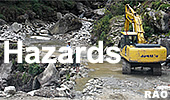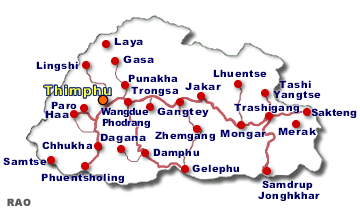| Natural Hazards in Bhutan |
 |
Bhutan Earthquakes |
 |
Sikkim Quake 2011 |
|
 |
Bhutan Earthquakes |
 |
Sikkim Quake 2011 |
|
|
 |
|
A 6.9-earthquake struck Northeastern Nepal and Sikkim (India)
|
 |
September
22, 2011
| At approximately 18.40 local time (12.40 GMT) on 18 September, a strong earthquake struck the northeastern Indian State of Sikkim which borders Nepal, Bhutan and China. According to the U.S. Geological Survey the epicentre was 60 kilometres (40 miles) northwest of the Sikkim State capital, Gangtok, at a shallow depth of 20 kilometres. Powerful tremors were felt across a wide area that includes Nepal, China, Bhutan and Bangladesh. Tremors were felt as far away as the Indian capital New Delhi - 1,000 kilometres from the epicentre. Media are describing the earthquake as the biggest in 60 years for the northeast of India. |
The September 18 earthquake damaged 12 dzongs and 175 lhakhangs, according to the preliminary damage report of department of disaster management.
 |
|
Of the 585 houses assessed for damage in Haadzongkhag, 49 two-storied traditional mud-house homes are reported to have totally collapsed following the September 18 tremors.
Another 133 are reported to have suffered major damage, which are beyond repair, according to a report compiled by dzongkhag officials as of 9 pm yesterday.
|
|
In the report released on September 20, Parodzongkhag reported the highest number of damages on the dzong and lhakhangs. Including the Ta dzong, 53 such structures were destroyed. "Both the inner and outer portion of Ta dzong are damaged," the report stated. "While major damage was caused to Dongkola, Ugyen Guru and Taktsang Zangdopelri lhakhangs, 24 lhakhangs were partially damaged and 24 lhakhangs had minor damage." Kila gonpa lhakhang was partially damaged, when fire gutted six houses of the nuns.
Major damage was also caused to Gasadzong's utse. The lam neten and umze's residence also developed cracks, along with the kitchen.
The utse of Lingshi dzong was completely damaged, and half of the lam's residence had collapsed.
Thirteen lhakhangs were damaged by the earthquake in Haa, one of the worst hit dzongkhags. The report, however, did not state the severity of the damage.
Samdrupjongkhar also reported four lhakhang damages in Augurthang, Dingshingzor, Samdrupchoeling and Lauri. A private lhakhang in Langchenphutoe was also damaged.
Numerous cracks were developed in Trongsadzong and damage on nine lhakhangs was also reported.
Meanwhile, 175 chortens were also damaged. Five chortens in Laja gewog, Dagana, had collapsed.
The report, however, stated that it is subject to change once it is verified and authenticated, after cross checking in the field by the dzongkhag authorities.
 |
| Contributed by Tashi Dema, KUENSEL, Bhutan's national newspaper, 22 September 2011 |
Damages in Samtse and Chukha - Extensive but not alarming
Bara and Chargharey in Samtse and Bongo gewog in Chukhareported extensive damage from the September 18 earthquake, as per the preliminary reports obtained by the dzongkhag officials so far.
In Bara gewog, which is about a day's walk from Tendu, a total of 122 houses were reported to have been damaged, of which 51 suffered major and 28 houses minor damage. Another 33 houses are reported to have been completely damaged.
Samtse dzongrab Karma Rinchen, who is in Bara gewog with his team, said the extent of damage wasn't as alarming as mentioned in the preliminary reports.
"We're classifying the damage into various categories," said dzongrab Karma Rinchen. "There are some houses that have been included as major damage but can be repaired ." "Minor damages are the ones, which are habitable and can be repaired, while the major damages are those that are beyond repair," said the dzongrab.
Most houses in Bara, according to the assessment team, were semi-permanent structures. "In some houses, just half of it are damaged, while the rest are still very strong," said the dzongrab.
All houses in Bara were insured, said the dzongrab, which the villagers were also happy about. "Since most people in Bara are quite well off, they managed to arrange temporary shelters on their own, but requested us that the insurance must come through soon."
A total of 117 houses were damaged at Chargharey, of which 86 houses suffered only minor damages, while 31 houses suffered major damage. However, there are no reports of houses being completely damaged as of now.
The preliminary report states that a total of 887 houses in Samtse's 15 gewogs were affected, with 590 suffering minor damage such as cracks, while 263 suffered major damages.
The disaster focal person of the dzongkhag, Dorji Wangdi, said the assessment teams were in all the gewogs by yesterday. "We're still gathering information from the teams," he said.
"The villagers, whose houses have been severely damaged, are distributed tarpaulin sheets," he said.
The Chargharey gewog administrative officer, Yeshi Zangpo, said affected villagers were putting up temporarily with their neighbours and relatives. "As it's too risky to stay even in the partially damaged houses, most villagers arranged temporary shelters on their own. But said they want assistance at the time of rebuilding their houses."
Chukha dzongkhag's Bongo gewog had the highest damage reported on 115 houses, of which 32 suffered major damage and 83 with minor damage, as per the preliminary reports.
Chukha dzongda Tshewang Rinzin said they will have a clear understanding only after the assessment team returns from the gewogs.
As per the preliminary report, Darla gewog follows next, with 104 houses affected, of which 18 were with major damages. As of yesterday, a total of 468 houses were affected, of which 110 are reported to have suffered major damage.
The Chukha dzongkhag has distributed 20 tarpaulin sheets to the victims, while another 350 tarpaulin sheets that were ordered from Siliguri, India, will be distributed.
"The students, whose houses have been completely damaged, will be provided temporary shelter in the school hostels," said the dzongda.
Both the dzongkhags are still gathering information from the assessment team sent to all gewogs. The figures are subject to confirmation, said dzongkhag officials.
 |
| Contributed by Kinga Dema, KUENSEL, Bhutan's national newspaper, 22 September 2011 |
| Links |
 |
 |
 |
External
link |
top
| Information on Bhutan |
 |
|






